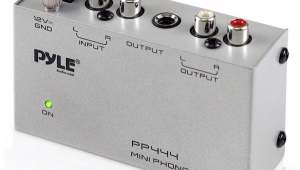Boulder 2008 phono preamplifier & 2010 preamplifier Page 4
That's gonna make EveAnna Manley unhappy, but the facts that the Steelhead is still one of the finest phono sections I've ever heard, the one I gladly bought, and one that costs about a quarter of what the Boulder costs, should take away some of the sting for both of us. No phono section I've ever heard comes anywhere near to matching the sonic performance of the Boulder 2008. As with the Rockport System III Sirius turntable, the 2008 belongs in Class A+ of "Recommended Components": a class by itself.
Boulder 2010 preamplifier
Once I'd gotten my ears around the 2008, I removed the Hovland HP-100 and inserted the Boulder 2010 preamplifier and its power supply. The control unit is big and heavy, and looks simple but elegantly bold. Like the 2008, the remote-controlled 2010 is fully balanced, so I swapped out the adapters, ran balanced cables from the 2008, and operated the Accuphase DP-85 SACD player (also under review) in balanced mode.

The 2010 also uses Boulder's 993 gain-stage modules of them—and is built and performs as a luxury product should. The two amplification modules are isolated, physically and electrically, atop a single chassis containing some of the control elements. Two sets of seven mirrored, flush-mounted buttons flank the large, mirrored volume control, which is flywheel-weighted and oh, so light and silky to the touch. This is not a volume potentiometer but a controller for the solid-state attenuator. One set of mirrored buttons includes six nameable inputs plus Record; the other set controls Balance, Mute, left and right polarity inversion (which you can program for each input individually), display intensity (eight levels plus Off), programming, and power.
I won't describe all this functionality, nor can I tell you about the remote control—for a variety of reasons, I didn't get one. Let's just say that the 2010 is a luxury product that looks, feels, and performs like one. You can balance input levels so you don't have to raise or lower volume when you switch sources, you can program a variety of functions, and you're given a precise volume level in dB on a large mirrored readout above the pushbuttons. You can even choose the coarseness or fineness of the volume control's operation. When you've set it up to your liking, it will do your bidding—as any $36,000 preamp should!
Adding the preamp only intensified the sonic experience already established by the 2008: the 2010 provided a bit more of everything that was great about the phono stage. This was not surprising—the 2010 uses the same 993 building block as the 2008—but the Hovland HP-100 held its ground in most areas, it's that good. In fact, on less than stellar recordings, I preferred what the tubes did, but through the 2008/Hovland combo I noticed no loss of impact or intensity when playing the best recordings. Whatever noise the Hovland's tubes introduced didn't translate into anything audible, and the lower noise floor of the Boulder didn't seem to improve low-level resolution or macrodynamic drive.
I seem to like having tubes in the mix, so while it's going to be hard to live without the 2008 (I'll find a way somehow), I can more easily live without the 2010. But the 2010 is fabulously built and provides the luxurious accommodations well-heeled audiophiles demand and deserve when they spend $36,000 on a preamplifier. If I could afford both, I'd buy them and be done with it. Though I haven't had the experience some have had with electronics priced at this exalted level, I've heard plenty, and I've heard nothing better than what this combination provided. Its dynamic performance was cathedral-like. From the most subtle shifts to the most explosive, it followed the musical gradations like a race car. It was open, transparent, endlessly resolving harmonically, and free of grain, glare, or any other audible or fatigue-inducing detritus.
You want big? The 2010 will give it to you. It painted a picture that was big, solid, and three-dimensional. With appropriately muscular and full-bodied speakers, you'll feel as if you're hearing everything your favorite recordings could possibly deliver. You'll probably be correct.
Conclusions
I've auditioned some mighty fine phono sections, and more contenders are waiting to be inserted in my system, but it's hard to believe that, for some time to come, any of them will equal or surpass the monumental performance of Boulder's 2008. That's why it and the 2010 preamplifier have gotten the full-review treatment instead of being covered in "Analog Corner."
When it came time to send the 2008 and 2010 to Stereophile to be measured and photographed, I insisted that John Atkinson come to my place to pick them up so that he could hear for himself what they and the Rockport Antares speakers delivered in my room. I played him Count Basie's 88 Basie Street, and Simon and Garfunkle's "The Boxer" and "The Only Living Boy in New York," from Classic's 45rpm reissue of Bridge Over Troubled Water. From his wordless, sputtering response, I don't think he'll find my enthusiasm for Boulder's electronics over the top.
When I first spoke to Bruce Van Allen about getting a 2008 for review, I asked if Boulder planned to actually sell a $29,000 phono section, as opposed to merely proving they could build one. He told me that dealers at CES had bought 10 of them. I was skeptical. He later told me that while the unit was in Boston, a Boulder customer who had come into Goodwin's for a listen said, "I don't want to buy a $29,000 phono section." After listening to it, he bout one.
Having listened for myself, I now believe Van Allen on both counts.
- Log in or register to post comments

















































